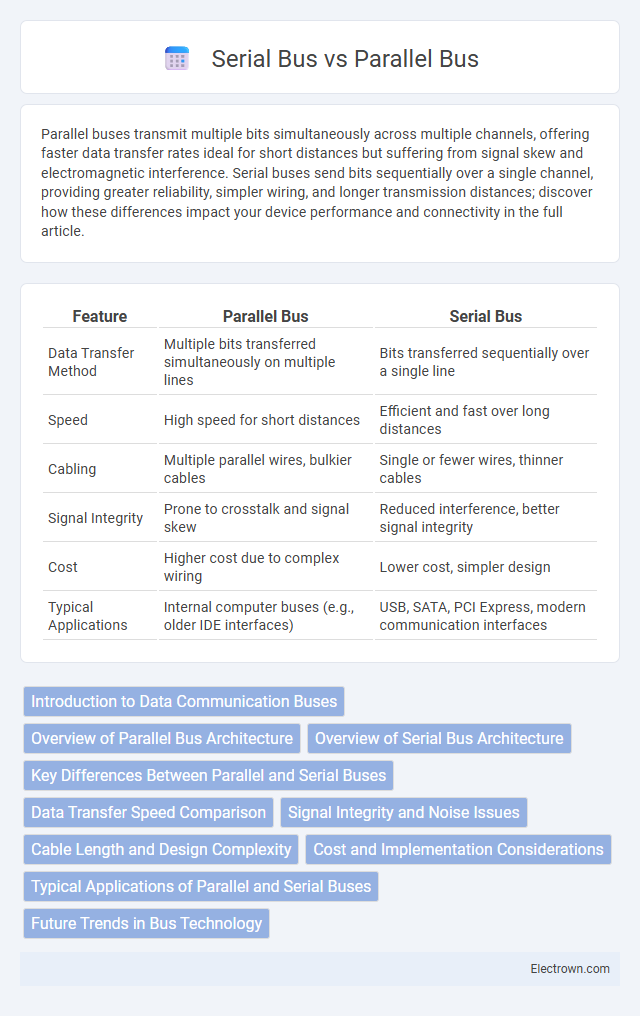Parallel buses transmit multiple bits simultaneously across multiple channels, offering faster data transfer rates ideal for short distances but suffering from signal skew and electromagnetic interference. Serial buses send bits sequentially over a single channel, providing greater reliability, simpler wiring, and longer transmission distances; discover how these differences impact your device performance and connectivity in the full article.
Table of Comparison
| Feature | Parallel Bus | Serial Bus |
|---|---|---|
| Data Transfer Method | Multiple bits transferred simultaneously on multiple lines | Bits transferred sequentially over a single line |
| Speed | High speed for short distances | Efficient and fast over long distances |
| Cabling | Multiple parallel wires, bulkier cables | Single or fewer wires, thinner cables |
| Signal Integrity | Prone to crosstalk and signal skew | Reduced interference, better signal integrity |
| Cost | Higher cost due to complex wiring | Lower cost, simpler design |
| Typical Applications | Internal computer buses (e.g., older IDE interfaces) | USB, SATA, PCI Express, modern communication interfaces |
Introduction to Data Communication Buses
Data communication buses serve as critical pathways for transferring data between components within a computer or between devices. Parallel bus transmits multiple bits simultaneously over multiple channels, offering high speed but facing issues with signal timing and electromagnetic interference over longer distances. Serial bus sends bits sequentially over a single channel, ensuring reliable communication with reduced complexity, making it ideal for modern devices requiring efficient long-distance data transfer.
Overview of Parallel Bus Architecture
Parallel bus architecture transmits multiple data bits simultaneously across multiple channels, enhancing data transfer speed within short distances. Each wire in a parallel bus carries a single bit, requiring synchronized timing to ensure accurate data transmission. Your system can benefit from parallel buses in environments where high-speed communication is essential and cable length is limited to reduce signal degradation.
Overview of Serial Bus Architecture
Serial bus architecture transmits data one bit at a time over a single channel, reducing the number of physical connections needed compared to parallel buses. This streamlined approach minimizes electromagnetic interference and allows for higher data transfer rates over longer distances. Your devices benefit from increased reliability and simplified wiring, which enhances overall communication efficiency.
Key Differences Between Parallel and Serial Buses
Parallel buses transmit multiple bits simultaneously across multiple channels, enabling faster data transfer but requiring more wiring and higher power consumption. Serial buses send data sequentially one bit at a time through a single channel, offering simpler wiring, reduced electromagnetic interference, and greater scalability. Your choice between parallel and serial buses depends on required speed, distance, and system complexity.
Data Transfer Speed Comparison
Parallel bus architecture transmits multiple bits simultaneously across multiple channels, achieving higher data transfer speeds for short distances due to simultaneous data lines. Serial bus sends data bit by bit sequentially over a single channel, often resulting in slower raw transfer rates but benefits from reduced signal degradation and improved scalability over longer distances. Advanced serial buses like USB 3.2 and Thunderbolt achieve comparable or superior speeds to parallel buses by utilizing high-frequency signaling and sophisticated encoding techniques.
Signal Integrity and Noise Issues
Parallel bus systems suffer from signal integrity challenges due to simultaneous multiple lines causing crosstalk and timing skew, which degrade performance at higher speeds. Serial bus architectures minimize noise and electromagnetic interference by transmitting data sequentially over a single or fewer lines, enhancing reliability. Your choice between parallel and serial buses significantly impacts data transmission quality, especially in high-frequency or long-distance applications.
Cable Length and Design Complexity
Parallel buses require shorter cable lengths due to simultaneous data transmission across multiple lines, which can cause signal degradation and timing issues over long distances. Serial buses support longer cable runs with simplified wiring, as data is transmitted sequentially on fewer lines, reducing electromagnetic interference and crosstalk. The design complexity of parallel buses increases with cable length and number of lines, while serial bus design remains simpler and more scalable for extended connections.
Cost and Implementation Considerations
Parallel buses generally incur higher costs due to the increased number of wires and connectors required for simultaneous data transmission, leading to more complex circuit board designs. Serial buses reduce implementation complexity by utilizing fewer lanes, lowering manufacturing expenses and enhancing reliability through simpler physical connections. Your choice between parallel and serial bus systems should balance the cost savings of serial communication against the speed advantages that parallel buses may offer in specific applications.
Typical Applications of Parallel and Serial Buses
Parallel bus systems are commonly used in applications requiring high-speed data transfer over short distances, such as internal computer components like CPUs, RAM, and printers. Serial buses dominate in longer-distance communications and peripheral connectivity, evident in USB, SATA, and Ethernet interfaces, where minimizing wiring complexity and electromagnetic interference is crucial. Understanding your system's data requirements helps determine whether parallel or serial bus technology best fits the intended application, balancing speed, distance, and cost.
Future Trends in Bus Technology
Future trends in bus technology emphasize the shift from parallel bus systems to high-speed serial bus architectures due to their superior data integrity, reduced electromagnetic interference, and scalable bandwidth capabilities. Technologies like PCIe Gen5 and USB4 demonstrate the industry's move towards serial buses that support faster data transfer rates and improved power efficiency for advanced computing and IoT devices. Understanding these developments can help you optimize system design for future-proof performance and connectivity.
Parallel Bus vs Serial Bus Infographic

 electrown.com
electrown.com